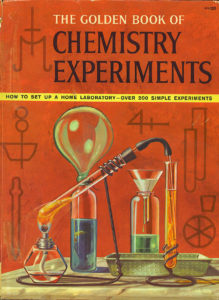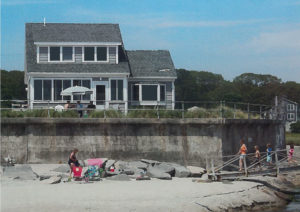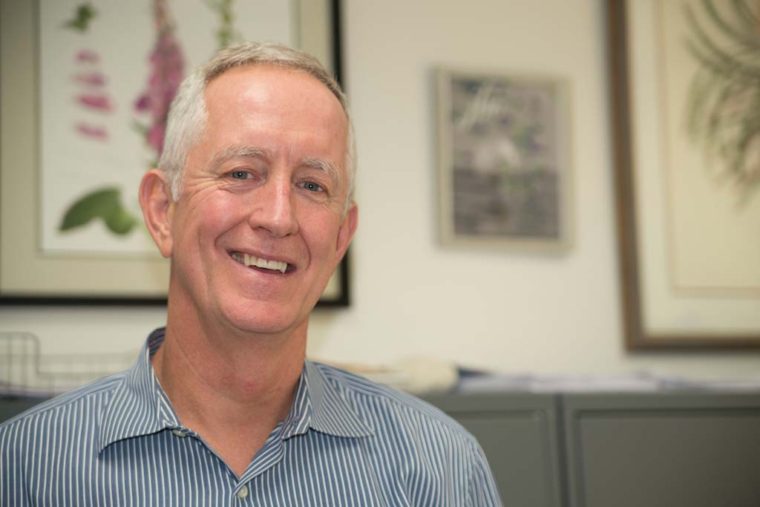“One of the wonderful things my father did for me,” Richard Vierstra said, “was to give me ‘The Golden Book of Chemistry Experiments.’

“One day I decided to make chlorine gas. Even at the age of 8, I appreciated that this could be a little dangerous, and so I set up the reaction in my sandbox.
“I did most of the experiments in the book,” Vierstra added. “It is astonishing that I survived, but that book made me into a biochemist.”
The same deeply ingrained curiosity that caused him to make chlorine gas from Clorox and Sani-Flush (don’t try this at home) has driven his exploration of the chemicals in plants that allow them to respond appropriately to light and to get rid of damaged or surplus proteins and other cellular junk.
A flash of light in the darkness
Nursery growers have long known that they can use light to fool ornamental plants into blooming at the wrong time. For example, they can stall chrysanthemums. which normally bloom in fall, until Mother’s Day by exposing them to light in the evening. And they can get poinsettias to bloom at Christmas by keeping them in the dark for at least 12 hours for at least five days in a row.
The plant sensor they are tricking measures how long the plants have been exposed to dark, not to light. A brief flash of light in the middle of a dark period resets a plant’s light sensor, zeroing it out, in effect, and making it start counting again.
In 1959, a USDA group announced in the Proceedings of the National Academy of Sciences that it had isolated the responsible light-sensing molecule, which they named phytochrome, from the Greek words for plant and pigment.
But the announcement was 25 years premature. “When I was a postdoctoral research associate at the University of Wisconsin in the early 1980s,” Vierstra said, “we realized that everybody was working on the wrong molecule.” The procedure scientists were using to isolate the protein allowed it to be degraded, and they were looking at a small fragment of a larger molecule.
In 1983, Vierstra finally purified and characterized the intact, entire molecule, a feat that secured him a faculty position at the university, where he was to stay 32 years.
Light exposure makes phytochrome flip back and forth between a biologically active and a biologically inactive form. The ratio between these forms allows the plant to sense its light environment in surprising detail.
“It can count photons,” Vierstra said. “It can figure out the light strength over an astonishing range of intensities and durations. It can measure day and night length. And it can detect the light’s color, providing a crude form of color vision.”
Twenty years of research in four seconds. Phytochrome consists of a small light-sensitive pigment (a bilin), called a chromophore (bright colors), buried in a larger protein (beige). When light hits the chromophore, part of it twists around a bond between two carbon atoms and this “twitch” deep inside the protein makes the larger molecule flex, kicking off a cascade of signals that tells the plant the light is on.
The chromophore’s twitch is translated into much broader movement of a part of the surrounding protein, called the “hairpin” (the outer orange spirals that turn into flat ribbons). Rotation and shortening of the hairpin splays sister proteins in the symmetrical molecule, and this initiates the plant’s response to light.
But there was a complication. Vierstra had worked on phytochrome in the lab of Peter Quail, a National Academy member who left in 1986 to start the Plant Gene Expression Center in Berkeley.
“I knew I couldn’t compete,” Vierstra said. “It was me in an office with a wastebasket up against a lab with 10 postdocs. So I decided to switch research topics — and, maybe, universities.
In 1983, he interviewed for a position at Washington University in St. Louis, arguing, in his “chalk talk,” that phytochrome could be used as a model to understand how cells break down proteins, because plants degrade the bioactive form of the photoreceptor. It was clear the degradative machinery can somehow tell the difference between the two forms and only attacked the one, he said.
At the time nobody knew anything about protein degradation — especially in plants. “I used to joke that as soon as I had one other person in my lab, we’d become the biggest lab in the world studying plant protein turnover.
“So I was at this interview talking about this whole process of selective breakdown and why you should hire me because I’d make great headway and blah blah blah, and Joe Varner at the back of the room yells out “‘Ubiquitin? What about ubiquitin? Could it be the tag that helped remove the active form?’”
Ubiquitin is a small protein that cells attach to unwanted or broken proteins to mark them for destruction.
“I had never even heard of it,” Vierstra said. “It had been described just recently. But Varner was a voracious reader of the literature, so he spotted everything early. I was thinking, ‘Uh-oh, this is not going to look good.’ I tried to avoid the question so I didn’t look like an idiot during this interview.
“But I went home and looked it up, and thought, ‘Wow this is really interesting, and it’s just breaking open.’ My first grant application, which I submitted to the USDA in 1986, was for research on ubiquitin. And guess who was the manager of the review panel? Joe Varner. He gave me the grant, and that got me started.”
But ubiquitin, which looked at first like a small research problem, exploded like a firecracker into a constellation of research problems. And after ubiquitin and protein disposal, he went after autophagy, a more general cellular disposal system, and that topic likewise exploded into many more problems.
His lab is still following all three lines of research, but now in St. Louis rather than Madison.
Lab dad and chief cook
In 2015, Vierstra returned to Washington University for more than just a job interview, becoming the George and Charmaine M. Mallinckrodt Professor in the Department of Biology in Arts & Sciences. Remarkably, nine members of his Madison lab moved to St. Louis with him.
Asked how he managed this, he said: “I would like to think it was something special that I had done. But they all were pretty interested in their projects and wanted to continue the work. It’s really great science.”
He is grateful to all of them. “I have known people who have left and gone to other universities without any of their lab members. They never recovered from that loss of collective experience,” he said. “If you try to go it alone, the lab is basically starting from scratch.”
Another Vierstra story, however, suggests that there might be more to it than this. There are indications he might be what is is sometimes called a “lab dad,” someone who watches out for his people and cheers on their work.
He is certainly a family dad. One of his extracurricular activities is rehabbing houses. It’s ingrained in him, like curiosity. And one of the houses he rehabbed recently is a cottage on Cape Ann, Mass., right on a beach with a 9-foot tide reach.


“My kids were moving all over the country, and I thought we needed to have a communal place where we could get together,” he said. “I said, ‘If I buy this house, I will view it as a family project, and I want you guys to all sign up for this, too. And they said I was abusing their human rights, but they all helped. Now when they get together at the house, they say, ‘See that? We did that.’ And it’s kind of fun to watch them.”
The house isn’t just for the immediate family. “One Saturday every year, we hold the cousins’ picnic there — maybe 40 to 50 people all show up — and I cook my mother’s clam chowder recipe, which is the best clam chowder I’ve ever had, and make clam cakes, which is a tradition in that area.”
Whether he’s framing a wall or devising experiments that will reveal the secrets of plants, Vierstra brings to the job the same unquenchable curiosity and willingness to rise to a challenge that motivated him as a boy.
“Like the crew of the Star Trek, you’re boldly going where no man has been before, and you kind of think that eventually you’re going to reach the edge of the galaxy,” he said. “But, fortunately for me, I’ve started projects in which I haven’t yet found the edge. We just go hurtling through biological space, realizing there’s more and more out there to discover.”
